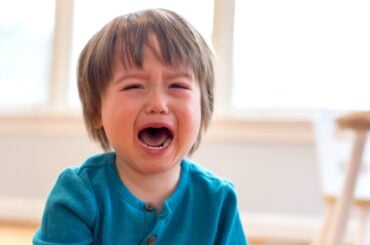Dealing with meltdowns, tantrums, and other behavior issues has always been among the biggest challenges parents face. Issuing “time outs” has long been a go-to method for calming children down, but the practice has come under scrutiny in recent years. Critics warn that the shame and isolation kids can feel as a result of time outs can deregulate emotional reactions even more, prevent children from learning anything from the experience, and teach kids that taking a moment to calm down is a punishment instead of letting them know it’s okay to take a break when they need one.
New research from the University of Michigan, however, shows that using “time outs” as a disciplinary measure is most likely not harmful to kids in the long term. This may come as welcome news to parents who are struggling with different discipline methods and everyone’s varying opinions about what effect they may have on children.
The study, published in the Journal of Developmental & Behavioral Pediatrics, examined 1,400 families with children in Early Head Start and the parents’ disciplinary strategies at 3, 5 and 10 years old. About a third of the parents used time outs, so outcomes later in childhood were compared against the families who did not use time outs.
It’s important to note, these results assume that parenting methods didn’t change over time.
One caveat is that the study assumed that parents’ use of time outs remained consistent as their child aged. This seems unlikely, considering most parents’ disciplinary tactics change over time as children get older.
Nevertheless, according to the data, children’s levels of anxiety, depression, self-control and rule-breaking did not increase after being subjected to time outs as a form of discipline. Among families where physical punishment was used, on the other hand, children became more aggressive over time.
The American Academy of Pediatrics does recommend time outs as one of several effective disciplinary strategies for children—but not necessarily the primary strategy since there are more positive ways to reinforce the behavior you want to see—while also warning against the harmfulness of physical punishment, yelling, and shaming.
Experts offer suggestions for making time outs successful at your house.
There are still some key guidelines that psychologists say we should follow if and when we do use time outs, to make sure they’re effective and not detrimental to kids. The study’s lead author, Dr. Rachel Knight, told the BBC that time outs should be conducted in a calm and positive way, without shouting, and that it’s crucial to make sure that both parents/caregivers and children understand the purpose and the process.
According to child psychologist Dr. Kate Roberts, it’s important to follow an established procedure with each time out: give the child a calm warning before instituting the time out; have a consistent safe place for the time out; only have them sit for as many minutes as corresponds to their age (i.e. a three-year-old can sit for three minutes).
It might be all about how you frame the time out—giving children (and parents!) space to calm themselves can be helpful.
Zero To Three, a non-profit focused on early child development, acknowledges that time outs aren’t right for every child. At the same time, so-called “time ins,” where parents offer extra comfort and attention to help a child calm down, aren’t really realistic when the child is kicking and screaming in full meltdown mode.
In those cases, they suggest the use of a “cozy corner.” Simply designate a spot in your home where anyone can go when they start to lose control of their emotions. Children can help set the area up with items they find comforting, such as blankets, pillows, art supplies, and stuffed animals. Parents can use the space when they need to calm down too, which also serves as powerful role modeling. Framing it as a chance to take a break (something the whole family can benefit from) can relieve the stigma and shame sometimes associated with time outs.
Most of all, parents should focus on getting to know their own children to figure out what’s best for them. For example, if time outs are too humiliating for your child, they might not be the most effective discipline strategy. You know your family best, and can use that knowledge to determine the best way to handle these tough situations.







